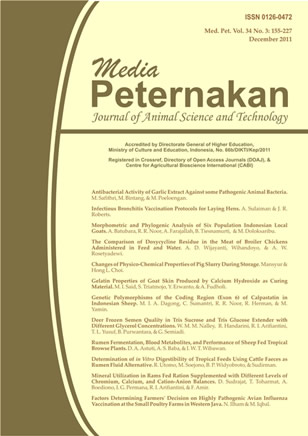Morphometric and Phylogenic Analysis of Six Population Indonesian Local Goats
DOI:
https://doi.org/10.5398/medpet.2011.34.3.165Keywords:
morphometrics, discriminant analysis, local goatsAbstract
The research objectives were to characterize morphometric and genetic distance between populations of Indonesian local goats. The morphological discriminant and canonical analysis were carried out to estimate the phylogenic relationship and determine the discriminant variable between Benggala goats (n= 96), Marica (n= 60), Jawarandu (n= 94), (Kacang (n= 217), Muara (n= 30) and Samosir (n= 42). Discriminant analysis used to clasify body weight and body measurements. In the analysis of variance showed that body weight and body measurement (body length, height at withers, thorax width, thorax height, hert girth, skull width and height, tail length and width, ear length and width) of Muara goats was higher (P<0.05) compared to the other groups, and the lowest was in Marica goats. The smallest genetic distance was between Marica and Samosir (11.207) and the highest were between Muara and Benggala (255.110). The highest similarity between individual within population was found in Kacang (99.28%) and the lowest in Samosir (82.50%). The canonical analysis showed high correlation on canon circumference, body weight, skull width, skull height, and tail width variables so these six variables can be used as distinguishing variables among population. The result from Mahalonobis distance for phenogram tree and canonical analysis showed that six populations of Indonesian local goats were divided into six breed of goats: the first was Muara, the second was Jawarandu, the third was Kacang, the fourth was Benggala, the fifth was Samosir and the sixth was Marica goats. The diversity of body size and body weight of goats was observed quite large, so the chances of increasing productivity could be made through selection and mating programs.Downloads
Download data is not yet available.
Downloads
Published
2012-01-31
Issue
Section
Articles



